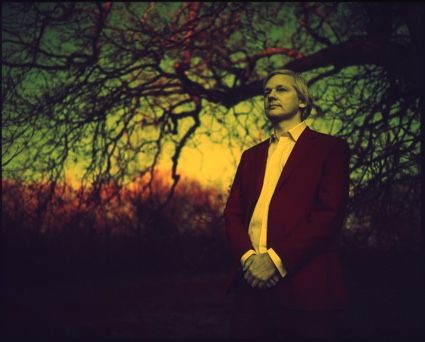 Jacob Appelbaum, Julian Assange, (Undisclosed location near Bail Mansion outside of London), 2012
Jacob Appelbaum, Julian Assange, (Undisclosed location near Bail Mansion outside of London), 2012
Next week, NOME, one of those too rare galleries exploring art, politics, and technology, is going to open Jacob Appelbaum’s first solo show in Germany. Titled SAMIZDATA: Evidence of Conspiracy, the show was curated by Tatiana Bazzichelli and accompanies the symposium SAMIZDATA: Tactics and Strategies for Resistance which will explore alternatives into the development of shared forms of post-digital resistance.
Jacob Appelbaum is an independent journalist, a hacker and a Wikileaks collaborator who helped develop the anonymous web browser Tor. He is also a U.S. citizen who has been living in exile in Berlin, due to an ongoing investigation into his involvement with Wikileaks and to repeated harassment at immigration. His situation offers a striking contrast with Ai Weiwei’s, a Chinese artist who has long been prevented from leaving his own country (although a few weeks ago, he was finally given his passport back and moved to Germany as well.)
Earlier this year, Weiwei and Appelbaum were invited to work together as part of Seven On Seven, Rhizome’s series of artists-meets-technologists events. The two of them met at Ai Weiwei’s house in Beijing and their collaboration was filmed by Laura Poitras, the director of the award winning documentary Citizenfour and another artist who has been living under the gaze of State surveillance.
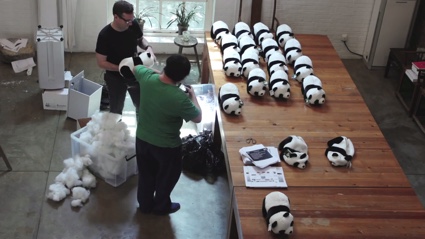 Still by Praxis Films
Still by Praxis Films
The video that documents their collaboration shows the artists working inside Ai’s studio, emptying the stuffing from toy pandas and replacing it with shredded N.S.A. documents released in 2013 by whistle-blower Edward Snowden. The work is called Panda to Panda, a reference to peer-to-peer communication but also an allusion to the Chinese secret police whose unofficial symbol is the panda. Sewn inside the stuffed toys are also micro SD memory cards that contain a digital archive of the intelligence documents.
The pandas were then sent to free-speech activists around the world and to museums, as a kind of distributed backup.
The Art of Dissent: Ai Weiwei and Jacob Appelbaum. Laura Poitras documents the dissidents Ai Weiwei and Jacob Appelbaum as they collaborate on an art project
Appelbaum will also be premiering at NOME a series of six colored infrared photos shown as cibachrome prints. Each of them celebrates a political dissident whose brave work has made them the targets of oppressive governments.
The portraits show William Binney, a former high official with the NSA who resigned in 2001 and has since spoken out against the NSA’s data collection policies. Glenn Greenwald, a journalist, constitutional lawyer, and author whose recent book, No Place to Hide, is about the U.S. surveillance state and his experiences reporting on the Snowden documents. Sarah Harrison, a British journalist, legal researcher, and WikiLeaks editor. She accompanied Edward Snowden on his flight from Hong Kong to Moscow while he was sought by the U.S. government. The other portraits show Laura Poitras, Ai Weiwei and Julian Assange.
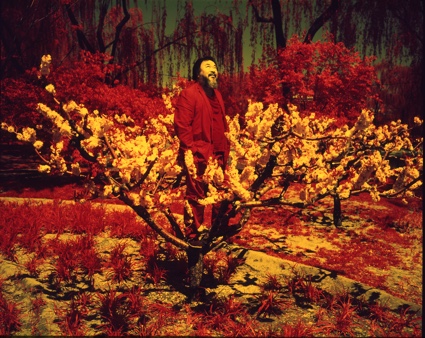 Jacob Appelbaum, Ai Weiwei (Bejing), 2015.
Jacob Appelbaum, Ai Weiwei (Bejing), 2015.
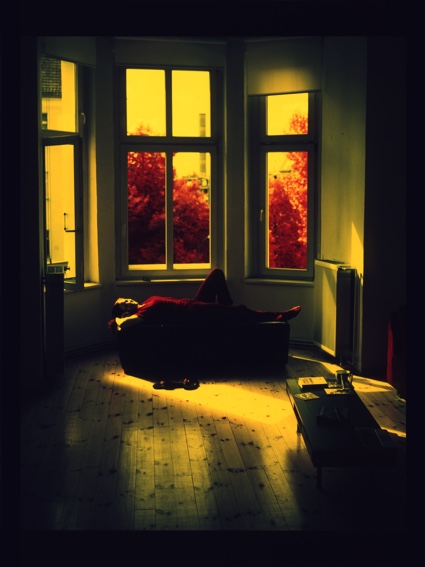 Jacob Appelbaum, Laura Poitras (Berlin), 2013.
Jacob Appelbaum, Laura Poitras (Berlin), 2013.
The fantastic people at NOME (thanks Tabea!) put me in touch with Jacob Appelbaum and we discussed over the phone about the exhibition, his experience of surveillance and the world of secrecy. Unsurprisingly, the conversation took place under the shelter of an encrypted calling app:
Hi Jacob! You are a U.S. citizens in exile and you are now living in Berlin. Do you find that an individual’s right to privacy is less under attack in Germany than it is in your own country? And do you think that this situation is likely to change and that Europe shows signs of becoming more and more open to surveillance and control of citizens?
Surveillance is a French word so it’s not as if surveillance came from the United States to Europe. Surveillance has been here for a long time. The first big data project of Europe was the holocaust, as documented in the book IBM and the Holocaust by Edwin Black. I think that it looks like at the moment there is a scary and worrying trend in Europe of moving towards the right wing with Le Pen and other groups across Europe and with that often comes a consolidation of State power and surveillance. It is very scary because if groups like the Golden Dawn, Le Pen, people who are in charge in Hungary at the moment and extreme right groups here in Germany, have control over these surveillance apparatuses, it will be very bad. I think it’s very bad already but it will just get worse. In particular with the Golden Dawn.
The political and cultural situation in Europe is not like the weather. It’s not just something that you observe. It’s not just something that happens. Rather it is something that we let happen and that we create by taking an active role in. I think that we are in fact changing this dialogue a great deal. It’s not just me and Laura and Glenn. It’s hundreds of thousands of people across Europe who really care about improving the LIBE committee in the European Parliament, the European Court of Human Rights, the Court of Luxembourg, etc. You can see that there are a lot of people who remember how surveillance has been used for in the 20th century and who understand that surveillance is not always used to prevent crime but in some cases is used to commit crimes. This is something that people in Europe understand and i think that the situation is changing precisely because this understanding is working its way into the common understanding and into the cultural discussion. But it’s not like the weather, it’s not changing on its own.
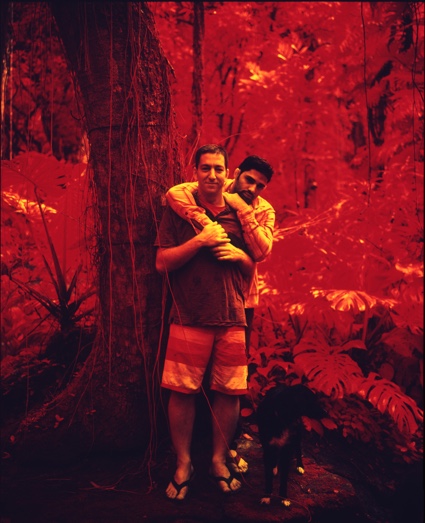 Jacob Appelbaum, Glenn Greenwald & David Miranda (São Paulo), 2012.
Jacob Appelbaum, Glenn Greenwald & David Miranda (São Paulo), 2012.
 Jacob Appelbaum, Sarah Harrison (Berlin), 2015.
Jacob Appelbaum, Sarah Harrison (Berlin), 2015.
I’d be interested to know about your choice of making portraits in cibachrome prints. Why did you use this photographic process?
I’ve been living under surveillance in some way or another for about 13 years. Maybe more. And in different capacities. In the last 5 years it has become very intense. The reason i mention this is because when you shoot with a digital camera and you plug in to a computer that’s on the internet, when you share photos on the internet, that’s it! They are no longer your photos. I’m sure that all the photos that i ever posted on the internet, on flickr for example, are sitting in an FBI database and i’m sure that they’ve been used to harm people and to harass my friends and people i work with. So i don’t really post photos on the internet anymore and as a result i started to work with slide film very heavily. I also started to keep my files offline and if i scan them, i keep them scanned on machines that are not connected to the internet and only for archival purposes. I felt that it made a lot of sense not to go to a professional printing studio and print digital photos of these slides but to actually do the entire process offline as much as possible. Cibachrome is the most analog process and it allows me to go low tech and that was very important for me. Cibachrome felt like the natural thing because it fits with the whole reason i was shooting slide films in the first place which was to regain my autonomy from surveillance.
The people your work portrays are involved in uncovering surveillance. I read some of the names in the list of captions for the photos of the show: Sarah Harrison, Laura Poitras, and William Binney. Who are the others and can you briefly tell you why you chose them?
The other people are Ai Weiwei who needs no introduction. David Miranda is in the photograph with Glenn Greenwald. He is the partner of Glenn Greenwald but also works with him around the Snowden affair. There’s Sarah Harrison, the woman who helped Snowden to seek and receive asylum, basically to escape from Hong Kong. Then there is Julian Assange, William Binney and then Laura Poitras.
 Jacob Appelbaum and Ai Weiwei, P2P (Panda-to-Panda) (Bejing), 2015
Jacob Appelbaum and Ai Weiwei, P2P (Panda-to-Panda) (Bejing), 2015
Apologies for the silly question but why did you decide to shred the information rather than stuff the pandas of the work Panda 2 Panda with whole pages randomly distributed?
Two reasons. The main reason is that i felt that it represented the way that people actually see the information anyway. Ideological information, economic information or the information that spies craft doesn’t make sense to a lot of people. It’s a specialized language. These shredded documents are the support structure of the actual body itself. But we also added a very small micro SD card inside the pandas. It actually contains the documents and then some. Which means that every single panda is the medium and the message in itself and it can be transported. We smuggled 20 of these pandas out of China and took them all over the world. That means that even if you took the whole internet down, even if you got rid of every website and of every member of the press, you’d have to actually also go and track down these 20 pandas. In addition to a lot of other things. The goal was then to have a piece of art in a museum that is full of this kind data and to make it so that the secret services wanting to erase it would have to go into the museum and destroy the pandas. Which places them very firmly in the aesthetic camp of being on the wrong side of history. In a sense, it’s like asking them “Come on! Get us! We dare you!”
How will Panda 2 Panda be exhibited exactly at NOME? With some of the pandas, the Poitras video and some information? What will the installation of the piece look like?
There won’t be any video. But instead we will have these 6 very large prints, nicely framed, mounted on aluminum and shadow boxes. We will also have the panda and the bag that it came in which is a beautiful Ai Weiwei bag which says ”Cǎonímǎ” which is this Grass Mud Horse (the word for internet censorship in China.) Weiwei and i signed this bag and it’s the transport for the panda. The panda is filled with documents that have been made public in the press.
But I decided that it wasn’t good enough. I wanted to create a final piece for the show that takes this project beyond what is public. For many years i’ve worked as a journalist shredding documents, either because we take journalistic notes about a source or we print out a document that we believe we wouldn’t legally be able to release without the risk of being arrested or something like this because it contains agent names, for example. And i have garbage bags full of these shredded documents. I just can’t throw them out. So i decided that that was going to be like the paint of a new picture. I collaborated with 3 other artists to make a hundred little necklaces. These necklaces are vials, like little test tubes, and inside of it are shredded unreleased documents. So a hundred people will be able to carry around the equivalent of the panda, except that it’s documents that have never been released. It reaches a totally different audience of people and in some ways it feels more risky but also less risky because it’s shredded documents. The piece is called Schuld, Scham und Angst which means Guilt, Shame and Fear in english. The reason behind that name is that i and all of the journalists who shredded documents and didn’t release every single one of them, we became in a sense collaborators with the secret state. And i’m distressed with myself for having to do that. The only time that it is ever appropriate to do that is for source protection reason.
Do you find that you and Ai Weiwei have a different approach to issues such as surveillance, secrecy and censorship? And how you express your opposition to them?
Yes, i do think that we are very different. We have complementary approaches. One is a coping mechanism. The other is a resistance strategy.
Weiwei is trying to document his whole life, to make himself as public as possible which in a sense raises his profile. Everyone talking about surveillance either vanishes or adopts this approach. Both Weiwei and i are both taking this approach to a degree.
I am also trying to raise the consciousness about this issue, to make sure that no one is victimized like this ever again. It’s not just about me. I think Weiwei also wants that to happen but it not clear to me –even with a work like Panda 2 Panda– that we change the fundamental structure of that kind of oppressive surveillance. But Weiwei is under much more oppressive surveillance than i am these days.
The work that i’ve done under the last 10 years is to make it hard for the people to monitor anyone who would be targeted for surveillance, whether they are legitimate so-called ‘targets’ or otherwise. But i also want to raise the consciousness about it and to raise the culture of discussion so that people start to ask ‘wait a minute! what does it mean to be a legitimate target?” I want to actually try and empower every person, not just special people, to free them from that kind of oppressive dynamic which in itself is a punishment and is often done in total secrecy. It happens in such a way that it corrodes life itself for people. So i want to fuck that up as much as possible.
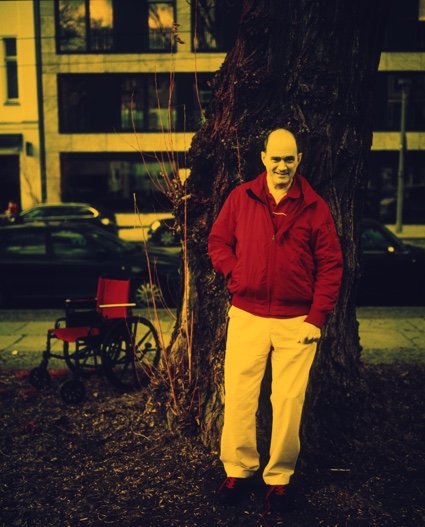 Jacob Appelbaum, William Binney (Berlin), 2014.
Jacob Appelbaum, William Binney (Berlin), 2014.
Do you think we should all assume that we are under surveillance?
No, i think we should all live with the assumption that we have the right to resist. It is our duty, in fact. We don’t have to live with the assumption that we are under surveillance. And in fact, when we do it then that tells us that we should take action.
Thanks Jacob!
Jacob Appelbaum — SAMIZDATA: Evidence of Conspiracy, an exhibition curated by Tatiana Bazzichelli, opens on 10th September, 6pm and closes on 31th October 2015 at the NOME Gallery in Berlin.
The event is organized in parallel with SAMIZDATA: Tactics and Strategies for Resistance which gathers hackers, artists and critical thinkers exploring possible alternatives into the development of shared forms of post-digital resistance. will take place on 11 and 12 September at Kunstquartier Bethanien in Berlin.
